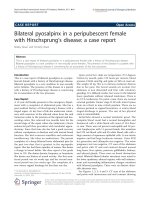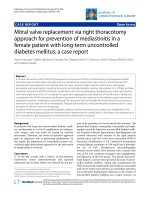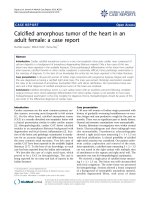Ascites in a bully female pup - A case report
Bạn đang xem bản rút gọn của tài liệu. Xem và tải ngay bản đầy đủ của tài liệu tại đây (152.72 KB, 3 trang )
Int.J.Curr.Microbiol.App.Sci (2019) 8(2): 2949-2951
International Journal of Current Microbiology and Applied Sciences
ISSN: 2319-7706 Volume 8 Number 02 (2019)
Journal homepage:
Case Study
/>
Ascites in a Bully Female Pup - A Case Report
Neelam*, Jai Bhagwan and V.K. Jain
Department of Veterinary Medicine,
LLR University of Veterinary and Animal Sciences, Hisar – 125004, Haryana, India
*Corresponding author
ABSTRACT
Keywords
Ascites, Hepatic,
Inappetance,
Haematobiochemical
Article Info
Accepted:
20 January 2019
Available Online:
10 February 2019
The present case study reports a case of ascites in a four month bully female pup, which
was presented with the history of progressive abdominal distension, inappetance and
weakness. Further detailed clinical examination and haemato-biochemical study confirmed
the ascites of hepatic origin. Treatment with antibiotics, diuretic, liver tonic and
hepatobiliary drugs resulted in complete recovery.
Introduction
Accumulation of serous fluid in the sac of
peritoneal cavity is referred as ascites. It is
one of the most common clinical problems
found in dogs.
It may occur due to number of etiological
factors viz. chronic hepatic failure, congestive
heart
failure,
nephritic
syndrome,
malnutrition, hypoproteinemia, protein losing
enteropathy, ankylostomiasis, abdominal
neoplasia of different origin and protein
loosing enteropathy (Randhawa et al., 1988:
Pradhan et al., 2008 and Sujata et al., 2009).
Since, ascites is also a clinical sign of some
underline disease conditions, detailed
investigations should be carried out to
identify the actual cause of the disease.
Case history and Clinical observations
A four month old bully mongrel female pup
was brought to TVCC, LUVAS, Hisar, with
the history of progressive abdominal
distension,
inappetence,
lethargy and
weakness since one week. Clinical
examination revealed pyrexia (103.20F),
distended abdomen on both sides with
palpable fluid thrill, dyspnoea, dehydration
and pale mucous membranes. Radiographic
examination revealed the ground glass
2949
Int.J.Curr.Microbiol.App.Sci (2019) 8(2): 2949-2951
appearance in abdominal and thoracic cavity
with slight pneumonic changes in lungs.
Haematological findings revealed 7.7 gm per
cent (%) of Haemoglobin, TLC (Total
leukocytes count) 13410/cmm and DLC
(Differential leukocytes count) - Neutrophils
86%, Lymphocytes 12%, eosinophils 1% and
monocytes 1%. The biochemical analysis of
serum revealed higher levels of serum
glutamic-pyruvate transaminase (SGPT) and
serum glutamic-oxaloacetic transaminase
(SGOT) 251 IU/L and 113.2 IU/L
respectively, and decreased level of total
protein 4.5 g/dl. Blood urea nitrogen and
serum creatinine levels were 22.49 mg%, 0.52
mg% respectively.
Treatment and Discussion
The dog was treated with Inj. DNS 100 ml
IV; Inj. amoxicillin and sulbactam @ 10
mg/kg I/M; Inj. furosemide @ 2 mg/kg I/M;
Inj. analgin @ 0.5 ml and Inj. Tribivet 0.5 ml
I/M daily for a week along with supportive
therapy with syrup livotas pet half tsf. b.i.d
for 20 days. The owner was advised to feed
chicken soup daily for 20 days along with
restricted
dietary
sodium
intake.
Subsequently, reduction in abdominal
distension was observed from 4th day of
treatment and the animal became completely
healthy by 20th day. The recorded clinical
symptoms simulated with Wadhwa et al.,
(1995) and Dabas et al., (2011).
Haematological examination, revealed slight
decrease in Hb concentration and leukocytosis
with neutrophilia (Rakesh and Shanti, 1994
and Kumar, 2002). Higher SGPT and SGOT
values were due to hepatic insufficiency with
hepatic damage resulting into leakage of
enzyme from hepatocytes into blood stream
(Cornelius et al., 1975). The level of total
proteins
indicated
hypoproteinaemia
(Skardova, 1991). Serum blood urea nitrogen
and creatinine values indicated normal renal
function. The detailed biochemical analysis
confirmed that ascites was of hepatic origin
and the same results were observed by Kumar
et al., (2016).
Since, the animal was suffering with chronic
illness
and
the
clinico-pathological
parameters were also suggestive of infection,
the line of treatment was chosen with
administration of higher antibiotic dose to
minimize bacterial infection via the portal
circulation, along with supportive therapy and
the pup responded well to the treatment.
References
Cornelius, L.M., Thrall, D.E., Halliwell,
W.H., Frank, G.M., Kern, A.J. and
Woods, C.B. 1975. Anomalous
portosystemic anastomoses associated
with chronic hepatic insufficiency in six
young dogs. Journal of the American
Veterinary Medical Association. 167(3):
220-228.
Dabas, V.S., Suthar, D.N., Chaudhari, C.F.,
Modi, L.C. and Vihol, P.D. 2011.
Ascites of Spleenic Origin in a Mongrel
Female Dog-A Case Report. Veterinary
World. 4(8): 376.
Kumar, A., Das, S. and Mohanty, D.N. 2016.
Therapeutic management of ascites in
GSD female dog. International Journal
of
Science,
Environment
and
Technology. 5(2): 654-657.
Kumar, S. 2002.Thesis Abstract. Journal of
Canine Development and Research.
2:78.
Pradhan, M.S., Dakshinkar, N.P., Waghaye,
U.G. and Bodkhe, A.M. 2008.
Successful treatment of Ascites of
hepatic origin in Dog. Veterinary
world. 1(1): 23.
Rakesh and Shanti. 1994. Ascites in a bitch.
Indian Journal of Veterinary Medicine.
18: 56-57.
Randhawa, S.S., Dhaliwal, P.S., Dua, S. and
Singh, K.B. 1988. Ascites of hepatic
2950
Int.J.Curr.Microbiol.App.Sci (2019) 8(2): 2949-2951
origin in dogs. Indian Journal of Animal
Health. 12: 165-166.
Škardová, I., 1991. Occurrence of ascites
abdominalis in dogs. The Journal of
nutrition. 121: 159-160.
Sujata, T., Randhawa, C.S., and Uppal, S.K.
2009.
Ascites
associated
with
ancylostomiasis in a pup: A case report.
Intas Polivet. 10(2): 357-359.
Wadhwa, D.R., Rao, V.N., Prasad, B. and
Mandial, R.K. 1995. Ascites in dogs
and its management. Indian Veterinary
Journal. 72(12): 1297-1299.
How to cite this article:
Neelam, Jai Bhagwan and Jain, V.K. 2019. Ascites in a Bully Female Pup - A Case Report.
Int.J.Curr.Microbiol.App.Sci. 8(02): 2949-2951. doi: />
2951









